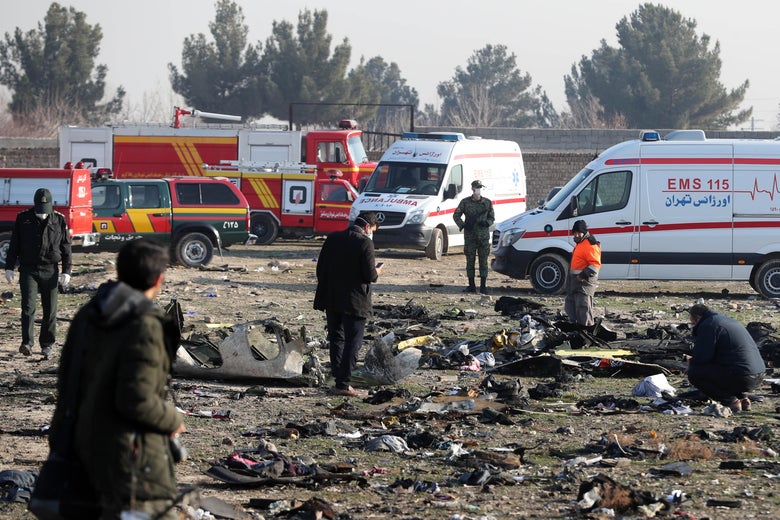What We Know So Far About the Mysterious Plane Crash in Iran Last Night
4 min read
By AARON MAK
Early on Wednesday, a Ukraine International Airlines jet traveling to Kyiv crashed shortly after takeoff from Tehran, Iran. The incident comes at a particularly tense moment in international affairs, just hours after Iran fired missiles at military bases housing U.S. troops in retaliation for the killing of Qassem Soleimani, a high-ranking official in the Iranian government who led the country’s elite Quds Force. Here’s a rundown of what we do and don’t know about the crash:
How did the crash unfold?
The plane, a Boeing 737-800, took off from Imam Khomeini International Airport in Tehran just before dawn and fell into an open field mere minutes later. Ukraine International Airlines indicated that the plane had ascended normally and reached an altitude of approximately 7,800 feet at a speed of more than 300 miles per hour in 2½ minutes before abruptly ceasing to transmit flight data. The pilot did not contact air traffic control to report any problems, and the plane also lost connection to the local control tower.
A video from the state-run Iranian Students’ News Agency purporting to document the crash shows that the plane was on fire while falling out of the sky and then caused a massive explosion upon impact. An Iranian newscast surveyed the site of the crash and found wreckage strewn about the field in small pieces.
Who were the casualties?
All 167 passengers—82 Iranians, 63 Canadians, two Ukrainians, 10 Swedes, four Afghans, three Germans, and three Britons—along with the nine Ukrainian crew members died in the crash. There were reportedly at least 25 children, 16 of whom were under the age of 10, and two newlyweds on board. The large number of victims from Canada makes this the country’s worst transportation disaster since 1985, when an Air India jumbo jet was bombed.
What was the cause of the crash?
Unclear. There have been a variety of conflicting reports and theories, but no one seems to have a definitive answer. Iranian state news and its Ministry of Roads and Urban Development have blamed the crash on an engine fire. The New York Times reported, however, that a plane can usually remain in the air even if one engine fails, and that it’s rare for engine damage to cause problems for other parts of the plane. The Ukrainian Embassy in Iran also initially cited technical failures as the cause, but soon retracted the statement and said that it was too early to come to any conclusions.
Some have speculated that the crash could be related to an Iranian missile strike that occurred a few hours beforehand. Iran fired more than a dozen ballistic missiles early Wednesday morning at two military bases in Iraq that housed U.S. troops. The attack was an attempt to retaliate for the killing of Soleimani, though there were no casualties or injuries. Commercial planes have been damaged in conflict zones in the past: In 2014, a Russian-made missile hit a Malaysia Airlines flight that was passing over Ukraine, killing 298 passengers.
The Iranian government has insisted that its missiles did not down the Ukraine International Airlines plane. Ukrainian President Volodymyr Zelensky has also urged the public not to speculate about the cause until more evidence becomes public. While the timing may be suspicious, there is currently no substantial evidence linking the strike to the crash.
Ukraine International Airlines has further claimed that there were three pilots on board and that the crew had considerable experience with Boeing 737s, so the chance of human error was unlikely, especially since the plane had ascended normally.
What does this mean for Boeing?
“This is a tragic event and our heartfelt thoughts are with the crew, passengers and their families,” said a statement by the company, which manufactured the 737-800 in 2016. The incident is potentially yet another black mark on the company’s safety record, as it is still dealing with the fallout of a software malfunction in the 737 Max that led to the deaths of 346 people over the course of two crashes in Ethiopia and Indonesia last year. The 737-800, however, does not have the same faulty software system. Boeing and General Electric, which helps to manufacture the 737-800’s engine, could eventually become involved in the investigation of the crash in Iran.
What will the crash investigation look like?
The escalating conflict between Iran and the U.S. is already complicating efforts to probe what happened in the crash. Under normal circumstances, the manufacturers of the plane and officials from the U.S. National Transportation Safety Board and possibly Ukraine would visit the impact site to assist with the investigation. Yet, in the immediate aftermath of the tragedy, Iran has signaled that it has little interest in cooperating and announced that it would not hand over the black box flight recorders to Boeing or the U.S. The Iran Civil Aviation Organization will instead be in charge of analyzing the contents. The Ukrainian government plans to send a search and rescue team to identify the bodies of those killed, and the U.S. has offered to help Ukraine and called for international cooperation in the matter.





